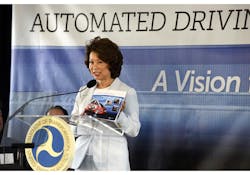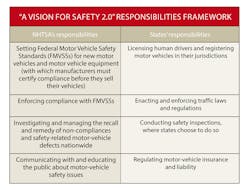One Step Forward, One Step Back for Self-Driving Car Regulations
Self-driving or automated-driving-system (ADS) cars are a regular topic for us at Machine Design. Our previous articles have highlighted the steps necessary to enact an ADS network. Cars need to be able to communicate with each other, communicate with traffic systems, and feature advanced sensors. Perhaps the most important factor, though, is regulation at the federal level.
The need for these regulations is important so that all car manufacturers work against set standards. This way Tesla cannot make ADS vehicles that operate different from Ford, which could lead to accidents. In addition, in the absence of federal regulation, states have taken to creating their own laws for ADS vehicles. This could prevent self-driving cars from crossing state lines.
Thankfully, the U.S. government has started to take steps in the right direction, albeit not strong enough. Last week, the House of Representatives passed the Self-Drive Act. The act takes steps to unify ADS regulations and laws by preventing states from passing and implementing their own rules governing the design or performance of highly autonomous vehicles. It still leaves states the power to enforce rules concerning safety, emissions inspections, traffic laws, and other traditional state handled transportation issues. This will most likely negate many of the laws that have already been passed by states in recent years. Thirty-three states in 2017 introduced new or additional legislation for ADS vehicles.
The second part of the act allows car manufacturers to deploy 100,000 self-driving cars per year (25,000 for the first year the law would be enacted) that would be exempt from existing automobile safety standards. This is important for car manufacturers to design without needing certain safety features like a steering wheel or pedals, such as that for Google’s self-driving vehicles. The act is moving on to the Senate, where autonomous trucks might be added to the bill as well.
U.S. Department of Transportation Secretary Elaine Chao speaks to a crowd of test engineers and car manufacturers in Ann Arbor, Michigan about the new “A Vision for Safety 2.0” guidelines for self-driving vehicles.
Guidelines for Manufacturers
While the U.S. government might be taking one step forward, it really feels more like a half step. The U.S. Department of Transportation Secretary announced a new set of voluntary guidelines for self-driving car manufacturers. Secretary Elaine Chao spoke at a facility in Ann Arbor, Michigan, where car manufacturers and engineers test technology for vehicles to communicate with streetlights.
At the gathering, Secretary Chao introduced the guidance document A Vision for Safety 2.0, released by the U.S. Department of Transportation and the National Highway Traffic Safety Administration (NHTSA). The guidance, according to Chao, “supports further development of this important new technology, which has the potential to change the way we travel and how we deliver goods and services.” According to the press release from NHTSA, the voluntary guidance will help car manufacturers with the following:
- Focus on SAE International Levels of Automation 3-5 – Automated Driving Systems (ADSs) – Conditional, High, and Full Automation.
- Clarify the guidance process, and that entities need not wait to test or deploy their ADSs.
- Revise unnecessary design elements from the safety self-assessment.
- Align Federal Guidance with the latest developments and industry terminology.
- Clarify federal and state roles going forward.
The guidance document outlines 12 safety elements that car manufacturers can follow to help design ADS vehicles. Some of the 12 safety elements highlighted by NHTSA are human-machine interfaces, crashworthiness, post-crash ADS behavior, data recording, and object/event detection and response. Click here for a PDF of the full guideline document.
The second section of the guidance document outlines the responsibilities of the NHTSA and the states. Echoing the Self-Drive Act, the responsibilities of enforcing compliance will fall on the federal government.
The guidance document “A Vision for Safety 2.0” highlights what responsibilities fall under the federal and state government regarding self-driving cars.
The ultimate goal of Vision 2.0 is to help foster production of ADS vehicles. The guidance scales back some of the regulations, reducing the previous guidelines under the Obama administration from a required 15-point safety assessment test prior to deployment to a 12-point voluntary assessment. As it states in the document, “This Guidance is entirely voluntary, with no compliance requirement or enforcement mechanism.”
Danger Lurks with Voluntary Status
While companies like General Motors are pleased with the scaled-back regulations, safety experts are upset with the new guidelines. Deborah Hersman, the president and CEO of the National Safety Council, pointed out that “DOT has yet to receive any Safety Assessments, even though vehicles are being tested in many states” since the first self-driving car guidelines were released last year.
By the federal government stating that the guidelines are voluntary, it takes away any enforcement power they have over car manufacturers to abide by the document. This can be dangerous if car manufacturers start to deploy ADS vehicles that do not have the proper safety regulations. Innovation that comes at the sacrifice for safety is not progress.
While the prospect of the Self-Drive Act is one-step forward to finally having federal government regulation over self-driving vehicles, the scaled-back guidelines will be the only documentation going forward that will direct car manufacturers—and it isn’t enough.



